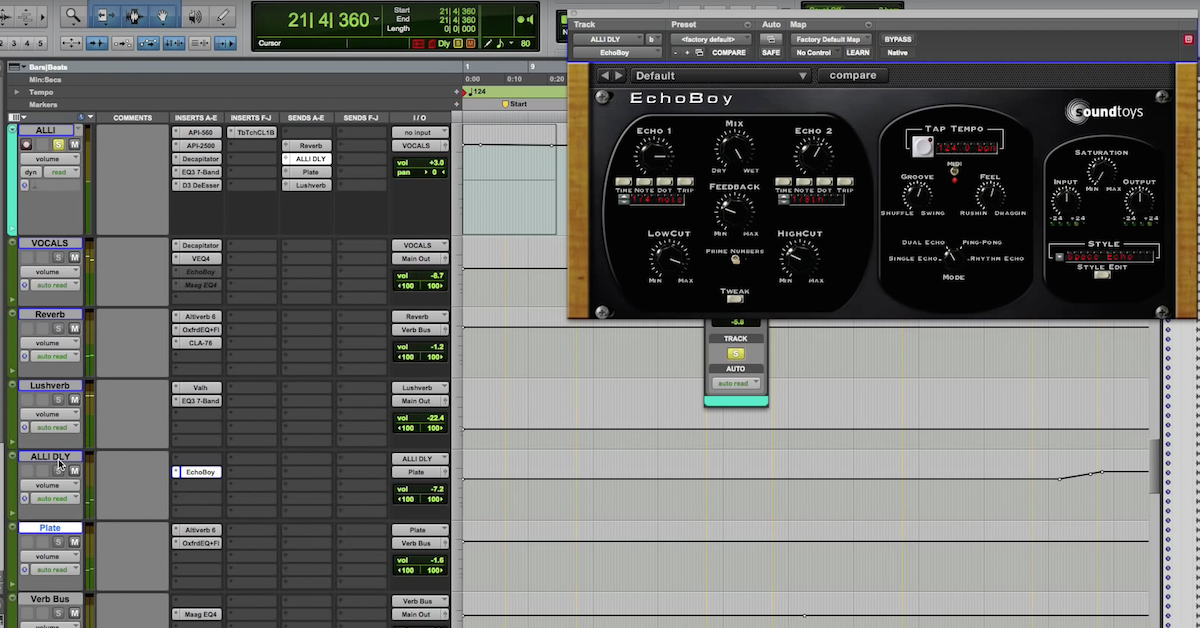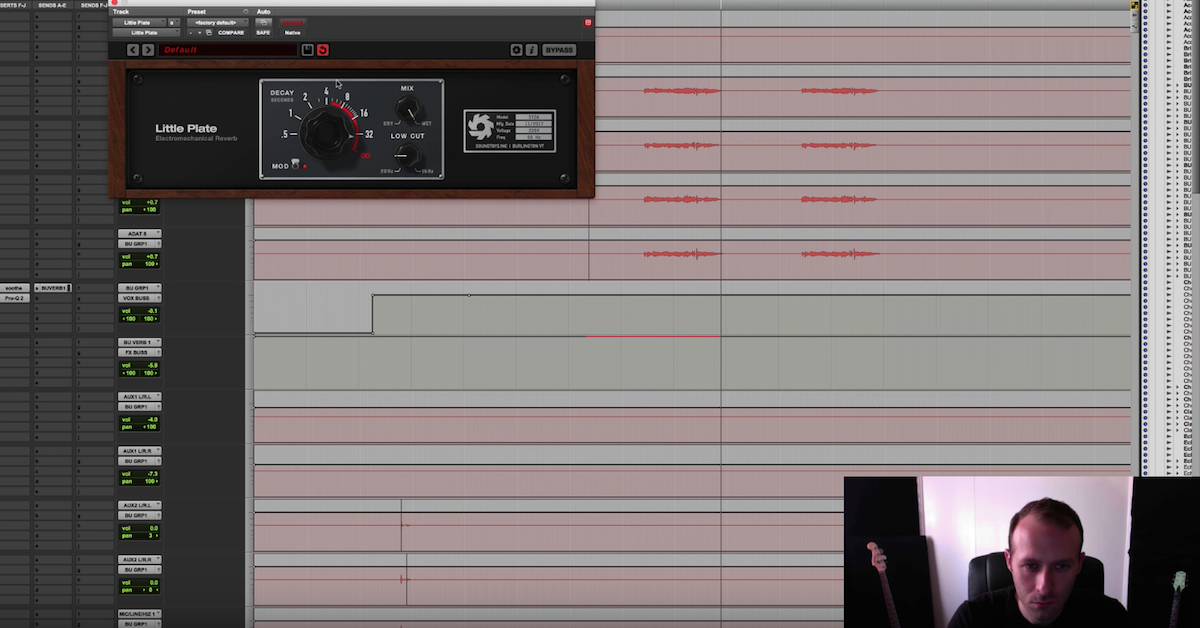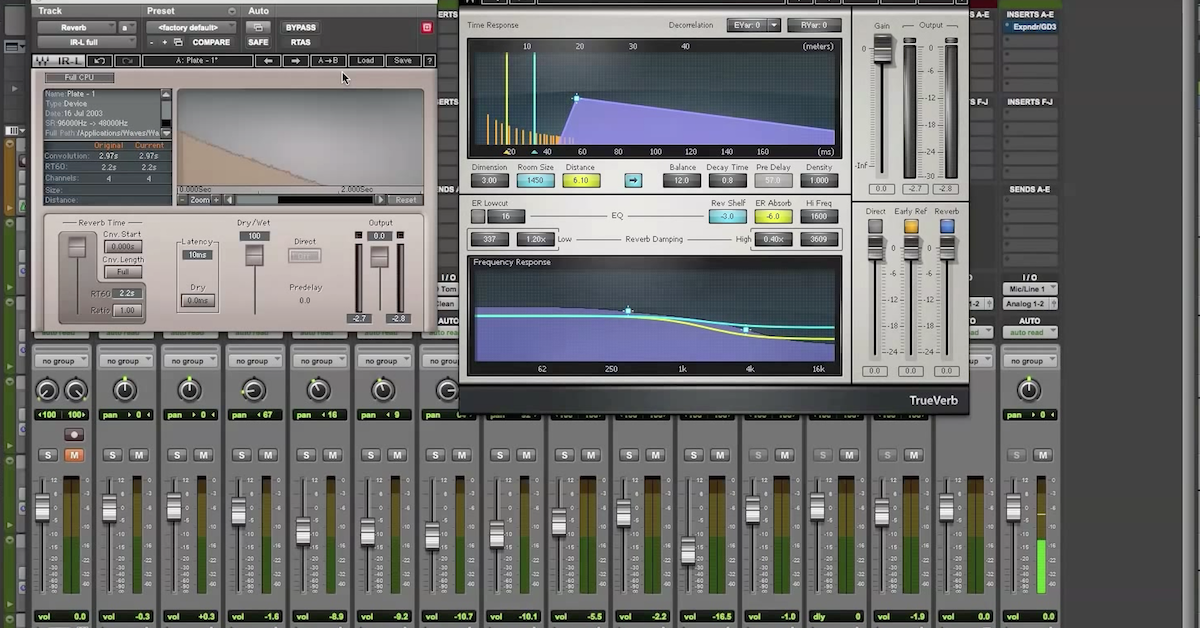16 Favorite Reverb Plugins (+ Mix Tips)
Article Content
Have you ever heard of the concept “feng shui?” It’s a practice that originated in ancient China that claims to enable humans to live more harmoniously with their environment. The idea is that we are connected to the different spaces in our homes, and if we make adjustments to these spaces by arranging them in ways that promote positivity, we will live happier (and healthier) lives. Strange way to open an article about reverb plugins, right? Not really. Reverb is space. If we don’t curate that space and caringly place our tracks within it, it can negatively affect our mix in a variety of ways. I’ll admit, I have a love/hate relationship with reverb. This might just be me, but sometimes I feel like I really have to put in significant work to make a reverb sit perfectly in a mix, far more work than it takes for me to feel satisfied with other types of processing like compression, saturation and even delay.
Worth considering is reverb plugins are essentially recreating many, many copies of whatever is fed into them, so if you’re sending in something that is deficient, you’re only multiplying the deficiency. So in that sense, while you can “hide” things using reverb, you can’t fix things with it. Once you understand this, and use reverb not as a band-aid but as a tool to create separation between elements (and to add character and tone to tracks), you’ll find that the elements of your mix will live more harmoniously with one another.
Here are my top 7 reverb plugins to use when mixing …
1. UAD EMT 140 Classic Plate Reverberator
The original hardware plate reverb from German company Elektromesstecknik was released in 1957 and revolutionized how reverb was used in the recording industry. The original 600 lb. EMT 140 Plate consisted of a thin piece of sheet metal suspended by springs and attached to a metal frame. A transducer attached to the center of the metal plate would vibrate the plate when it was fed signal, and one or two pickups mounted to the plate would return the vibration of the plate. The design evolved over time, but the legendary sound of the EMT 140 was preserved in the form of thousands of records on which it was used. When I found out that Universal Audio captured the dense, natural, versatile beauty of the EMT 140 and created a plugin that weighed significantly less than 600 lbs., I was sold.
I use this plugin all over the place when mixing. I’ll use it on vocals, guitars, pianos, strings, horns, even drums. Occasionally, I’ll create an auxiliary track, insert an instance of the 140 and send several elements to it, which creates a lush sense of cohesion. Some mixes require a more subtle application of reverb, and the 140 works well with shorter reverberation times in the .5 to 1.5 second range. Other mixes call for reverb to be more prominently featured and the 140 shines here too, as the longer reverb times combined with the modulation (MOD) feature create a beautiful, detailed reverb tail which is perfect for ethereal, dramatic lead vocals.
Mix Tip
Sometimes a dense, washed out sound is in order, and I quite enjoy combining reverbs. Obviously, in this context I am not going for a natural reverb sound. The EMT 140 works great when combined with another reverb, in particular because it offers you so much control. You’ve got the multiple types of plates included in the plugin, reverberation time, an input filter for taming low end, stereo width, an onboard equalizer, modulation and pre-delay. Because of this, the EMT is incredibly flexible and not only works well on its own but plays well with others.

2. FabFilter Pro-R
As you’d expect from FabFilter, Pro-R is loaded with leading-edge features, a sleek user interface and impeccable sound quality. It can sound natural, other-worldly and everywhere in between. The space knob allows you choose from over a dozen room models which offer decay times ranging between 200 milliseconds and 10 seconds. The brightness, character, distance, decay rate and stereo width allow for additional control over the sound of the space in which you place your signal. Pro-R goes even deeper by incorporating a decay rate EQ and a 6 band post EQ. In physical spaces, high frequencies usually decay quickly while bass frequencies linger. The decay rate EQ allows you to fine tune the decay rate across the frequency spectrum, which is great for subtle fine tuning of reverb tails or creating wild, unnatural sounding reverbs. Lastly, the post EQ enables you to sculpt the overall tonality of your reverb.
Mix Tip
Get weird with this one. Experiment with unorthodox decay rate EQ curves, different character and brightness settings and tweak (or even automate) the post EQ for reverb tails that sound unique and unlike anything you’d find in actual physical spaces.
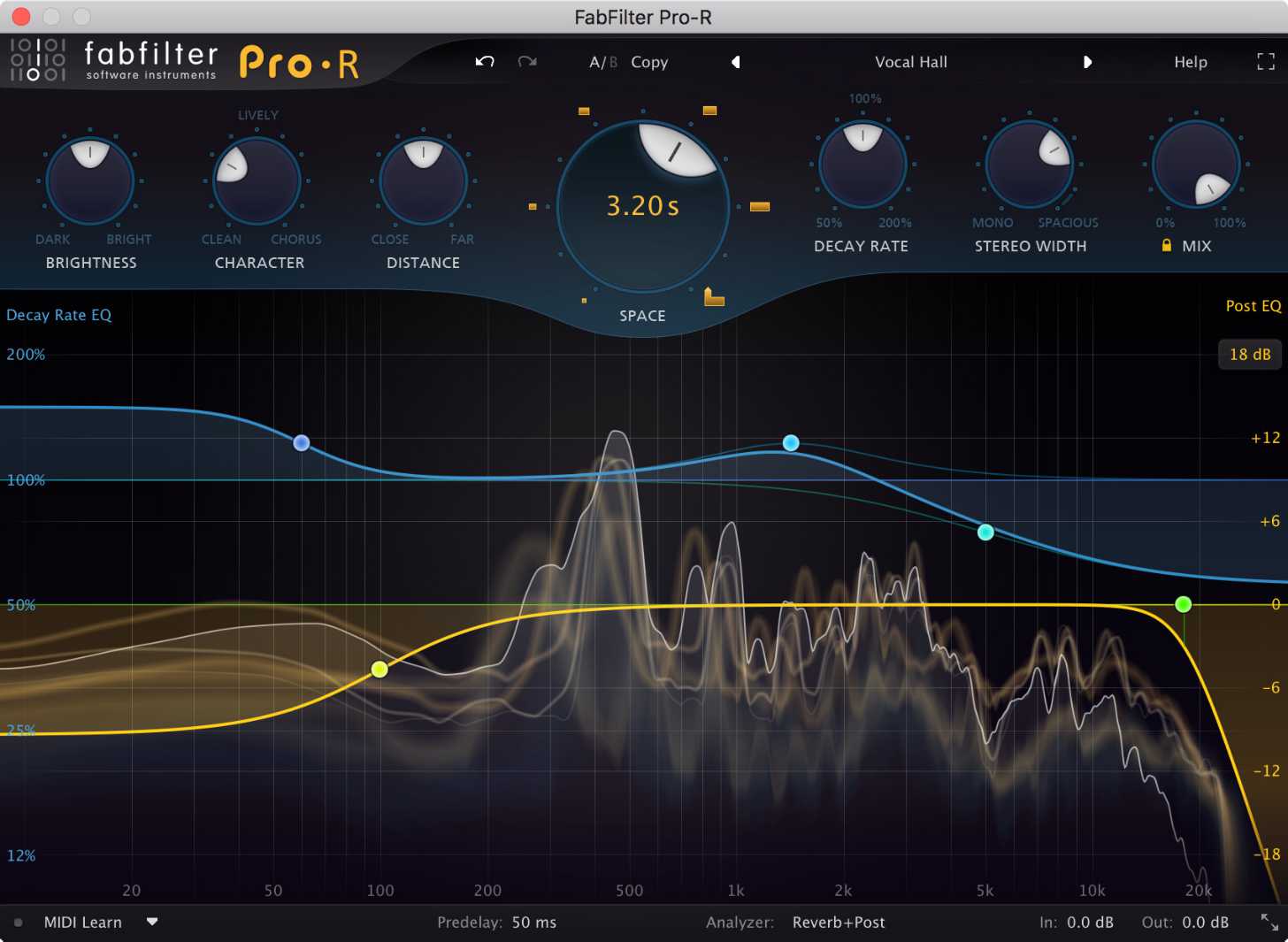
3. Valhalla VintageVerb
Described as a “postmodern reverb plugin, inspired by the classic hardware digital reverbs of the 1970s and 1980s,” VintageVerb covers a lot of sonic ground. The minimalist GUI, which is a trademark of all products from ValhallaDSP, is a treat on the eyes. VintageVerb comes with 18 different reverb algorithms that include chambers, rooms, plates and more. It offers a lot of control over the different elements of your reverb, but because the user interface is so intuitively designed and clearly laid out, it never feels overwhelming or crowded.
If you’re interested in a free foray into the wonderful plugins from Valhalla, check out Supermassive.
Mix Tip
Play VintageVerb like an instrument by mapping parameters to a MIDI controller. I’m all about adding performative elements to mixes in unexpected ways. Think of the additional level of musicality, depth and feeling that can be added by performing simple fader rides, and then consider that you can do the same by automating plugin parameters. VintageVerb has so many controls that lend themselves to be used in this manner. Map the parameters to your controller of choice in your DAW and have fun!
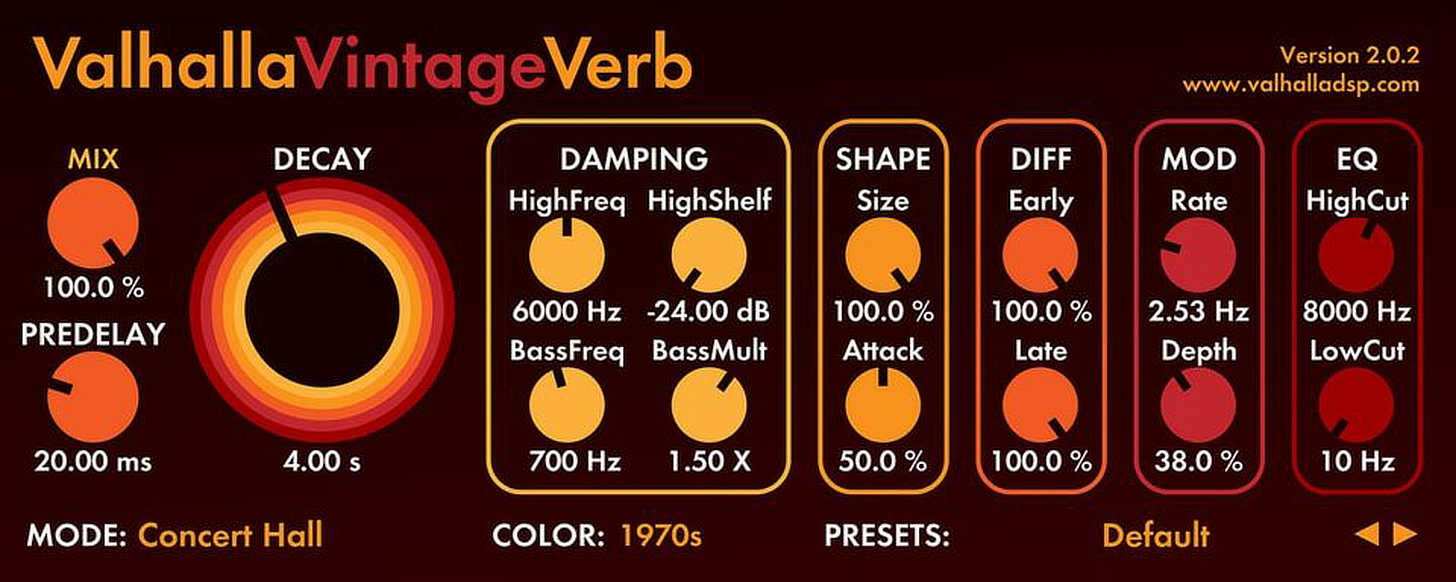
4. Soundtoys Little Plate
This is another emulation of the classic EMT 140, but Soundtoys took a minimalist approach here by putting only four controls total on the user interface of Little Plate: modulation, mix, low cut and a big ol’ decay knob. That’s a strength, not a weakness however, because sometimes less is more. I can dial in a thick, musical reverb sound in mere seconds using Little Plate.
Mix Tip
The decay knob goes to infinity. Utilize it. Send a sound through Little Plate, preferably a single note or chord — otherwise the sound will get overly dense and dissonant pretty quickly. Use this never-ending reverb tail however you see fit. Automate it, process it, print it, chop it, whatever.

5. Audio Ease Alitverb
If you’re looking for an all-in-one convolution-based reverb solution, it’s hard to argue against Altiverb 7, which is widely used in both music and audio post-production. If you need to make your sounds seem as if they are in halls, rooms, chambers, clubs, stadiums, cars, trains, boats or as if they are being run through plate, spring or digital reverb units, Altiverb comes loaded with impulse responses for these and more.
Mix Tip
Combine impulse responses. Embrace the unnatural. To be honest, it’s somewhat rare that I am trying to establish an entirely natural, believable sense of space when mixing music. You wouldn’t figure that placing a lead vocal in a mausoleum, while placing synthesizers in a stadium and placing a string quartet in a toilet is advisable, but Altiverb allows you to do just that. You’ll never know until you try.
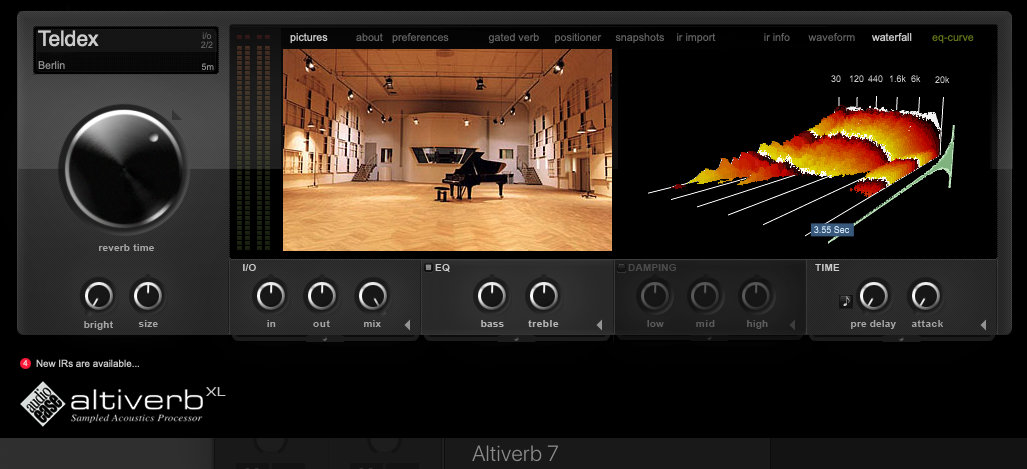
6. Any (or All) Of These Reverbs From UAD: AKG BX 20, Capitol Chambers & AMS RMX16 Expanded
I didn’t want to have virtually every other plugin on this list be one created by Universal Audio, but the truth is you’d be well-served to have all of these emulations of classic spaces/gear in your arsenal of reverberators. Each of these offer authentic reverb sounds that have been heard on countless records through the decades.
Mix Tips
The AKG BX 20 is a spring reverb, similar to the type you’d find within a guitar amp. Try placing an amp simulator plugin in front of the BX 20 in your signal path for an instant re-amped sound. It works great on vocals, percussion and of course, DI guitars.
The Capitol Chambers emulates the classic sound of the spaces beneath the Capitol Tower in Hollywood, and it works splendidly in both vintage and modern contexts. Out of any reverb plugin, I’d have to say that I like using this one in mono the most, as it offers an instant 1960s character.
The AMS RMX16 Expanded was designed by Mark Crabtree. The legendary RMX16 Hardware unit surely isn’t a one-trick pony, as it offers a wide variety of effects (not limited to reverb), including echo, chorus and reverse. While I absolutely recommend using the classic nonlinear sound for an instant 1980s character, don’t deny your productions all of the other great sounds that the RMX16 has to offer.

7. PSP SpringBox
This offering from seriously underrated plugin makers PSPaudioware offers a different flavor than the previously mentioned AKG BX 20 — it’s brighter and more jangly. It also offers a bit more control over sculpting the shape of the reverb tail. As with mostly everything that PSP has released, the user interface is intuitive, and the sound is rich and full of character.
Mix Tip
Try adding compression after SpringBox for a more in-your-face spring reverb sound.

8. Baby Audio Spaced Out
I had a bit of difficulty deciding which plugin roundup Spaced Out should be included with. While it is a reverb, it’s also a delay, a modulator and, truthfully, it’s a musical instrument unto itself. If you simply want a quick to dial-in, inconspicuous-sounding reverb, perhaps you’d be better suited looking elsewhere. But if you’re looking to really craft something unique, memorable and beautiful, Spaced Out offers a lot more than other plugins included in this list. As with all of Baby Audio’s plugins, the GUI is stunning and encourages exploration. The center “space” module controls the plugin’s reverb effect and comes with four unique programs — vacuum, small space, medium space and outer space. It also features controls for pre-delay, “stardust” (which is a gorgeous octave-up shimmer effect), “mellow” (which adds low and high end damping filters), “clean-up” (which feeds an altered signal into the reverb, resulting in a less dense response) and a “width” control. In the middle of the plugin is an X-Y based “joystick” control that allows the user to morph between the reverb length and modulation behavior. As you can tell, this plugin goes deep, so I definitely suggest putting the time in to learn the many different controls.
Mix Tip
Don’t wait until you reach the mix stage to incorporate Spaced Out. My first experience with the plugin was with my guitar plugged directly into Logic, with that signal then sent to an auxiliary track with Spaced Out inserted upon it. The sounds I was achieving were dramatic, ethereal, lush and sometimes unruly. These are the kinds of sounds that you build an entire production around, not generally the kinds of sounds you want to “fit in” to an already fleshed out production. If you simply want to use Spaced Out in a more conservative way as a subtle delay and reverb effect, then by all means go for it, but I personally feel as if this plugin is best utilized expressively during the production stage.
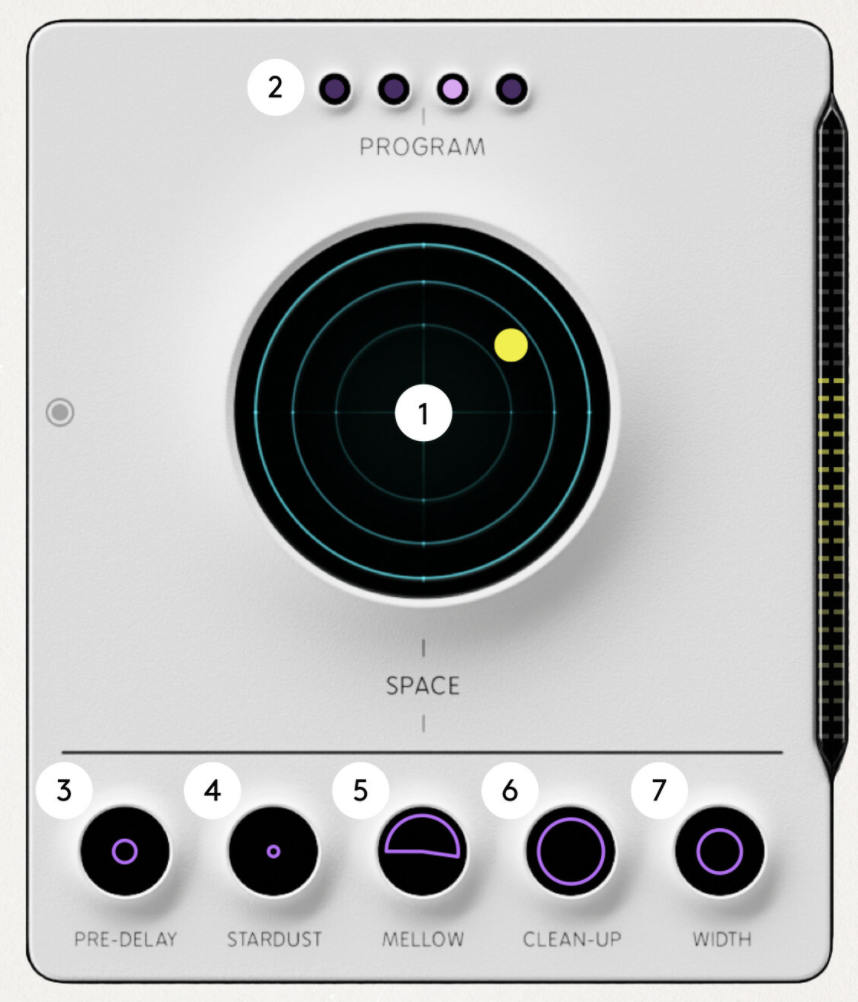
9. Klevgrand Kleverb
Swedish plugin makers Klevgrand design gorgeous pieces of software that work on Mac, Windows and iOS. Kleverb is a stunning reverb plugin that features an intuitive user interface and lush sound. Although there are many useful features on Kleverb, the UI never feels crowded or busy — the parameter layout is easy to understand and inspiring to control. Visuals aside, the sound quality is stunning. There is an EQ/filter section for both the early and late reflections, allowing the user to sculpt their reverb tones with precision. You can choose between large, medium and spall spaces, as well as control the pre-delay, damping, diffusion, spread and decay (up to 25 seconds) of your tails. There’s a modulation section that helps add movement and depth to your reverb sound, and you can blend between the early and late reflections. Klevgrand has also added a unique ducking feature that I’ll address more in the upcoming mix tip.
Mix Tip
The ducker ingeniously takes the dry signal and lowers the reverb while it’s active, allowing for a less muddy reverb sound. This feature is perfect for dense arrangements and I’d love to see it incorporated into more reverb plugins.
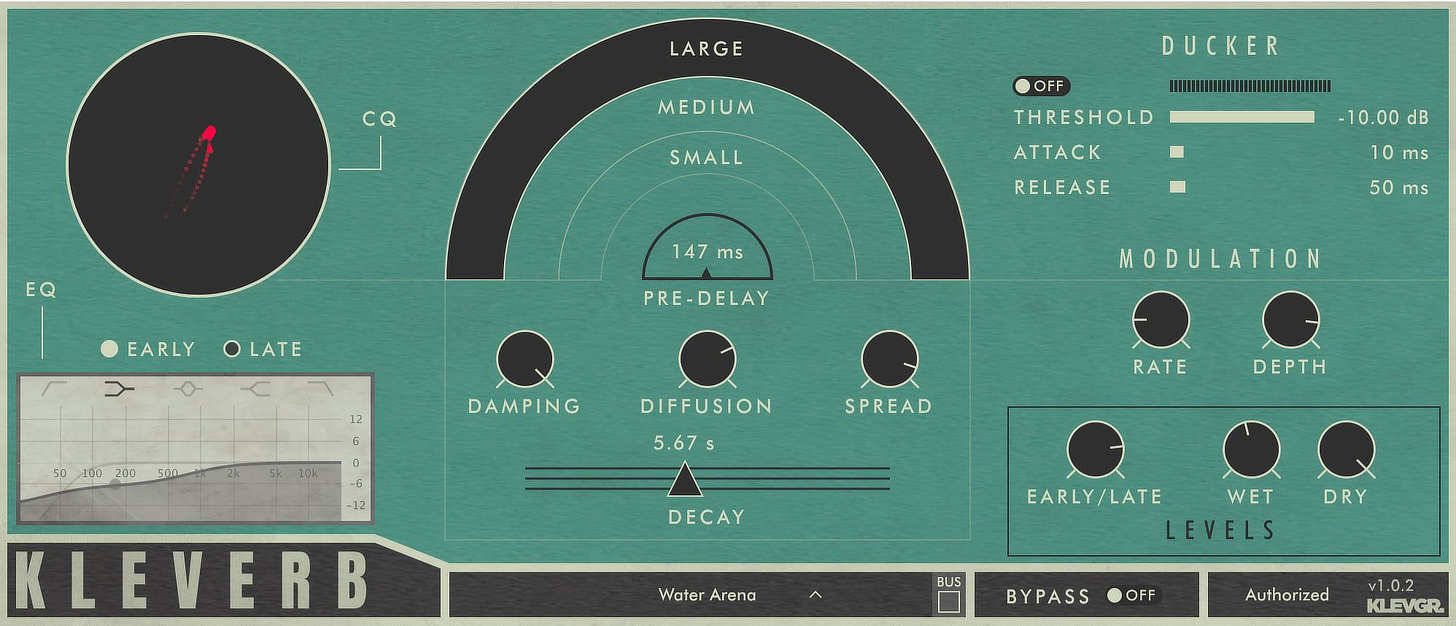
10. Baby Audio Crystalline
Baby Audio continues their winning streak with Crystalline, a plugin that also serves as a love letter to the most popular algorithmic reverbs throughout the history of music production. Companies such as Lexicon and EMT forged a path with their digital reverb hardware units, and Baby Audio adopted concepts from these pieces and then packed Crystalline with impressive modern features.
Crystalline was created to go beyond the limitations of realistic-sounding reverb, and it does so in style. The gorgeous GUI feels like an expensive little boutique toy; I can almost sense how it would feel beneath my fingertips if it were a physical desktop hardware unit.
The features are too numerous to list here, but some of my favorites include:
BPM-synced start and end times. Crystalline lets you hard-sync the reverb attack and decay time to your DAW’s tempo.
The “sparkle” control emphasizes high frequencies inside the reverb algorithm. This generates reflections that are naturally brighter, which will help you achieve that extra shine on sources like vocals or snare drum.
There’s a helpful “ducker” control which lowers the reverb signal when the dry/incoming track is playing. The ducker gives you a cleaner mix, where you can turn up the reverb more without muddying up the dry track.
Mix Tip
It helps to not have traditional expectations when first loading up Crystalline — it wasn’t designed to operate like a classic reverb. I almost view it as more of a tool for production than one for mixing. It can generate otherworldly sounds, so don’t restrict yourself by trying to only achieve a familiar room sound or ambience when using it.
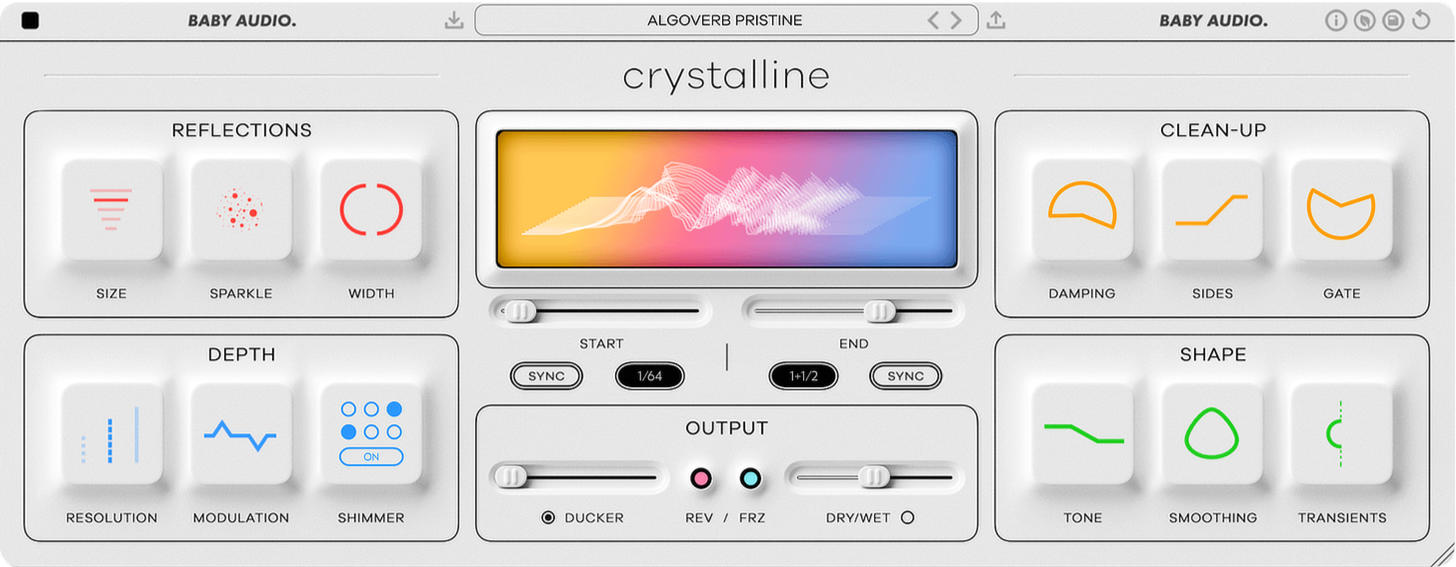
11. Unfiltered Audio Tails
I’m consistently surprised by the ingenious software makers at Unfiltered Audio. Tails, their esoteric reverb plugin, is no exception. The thoughtfulness and creativity that went into its creation is second to none. With a unique “polytonal dual buffer” feature and auto-ducking capabilities, Tails automatically removes dissonances and transients from your reverb tails, keeping your decays as pristine as possible.
Tails is chock full of useful parameters. There are four separate reverb modes including a sought-after shimmer mode which adds in a blooming transposed tail, a sample rate control for creating lo-fi reverbs, saturation, EQ, damping for tone shaping, MIDI integration that allows users to alter reverb parameters on their MIDI controller and even a randomization function which can be triggered to create wildly unpredictable reverb sounds.
Mix Tip
The ducking feature is a bit challenging to wrap your head around at first. Basically you can set Tails so that it will create a sustaining reverb on a source (let’s say a piano playing a chord) until it receives transient information that passes over a certain threshold. In this example that transient would come from a second chord being played — at which point the initial tail will be cut off, and a new tail will be created. It allows for incredibly musical reverb tails free of dissonance and harmonic muddiness.
Check out these sound clips to hear Tails, with shimmer mode in action:
⇧ Tails Piano Demo Dry (no processing)
⇧ Tails Piano Demo Wet (with processing)
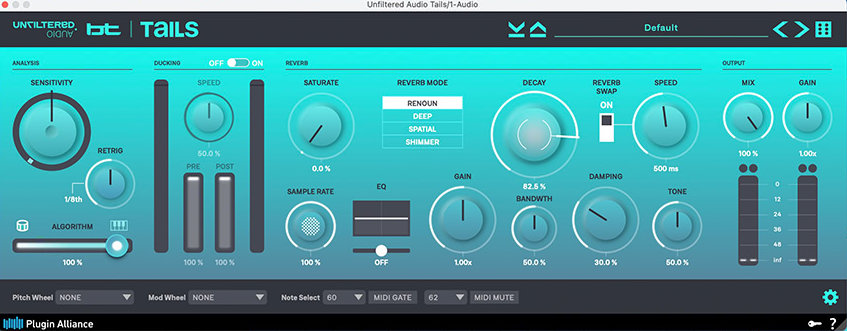
12. Slate Digital VerbSuite Classics
In partnership with LiquidSonics, Slate Digital has released Verbsuite Classics. It’s an impressive collection of emulations of vintage hardware reverb units. While the actual brand names aren’t used, Verbsuite includes recreations by companies like EMT, Bricasti, AMS and more. VerbSuite allows for just the right amount of tweaking, with controls for decay, attack, pre-delay, chorus, width, a 3-band EQ, dry/wet blend and a super helpful A/B system for comparing settings. For wild, warbly or otherworldly tails I might look elsewhere — but for a collection of solid vintage reverbs, VerbSuite Classics is a safe bet.
Mix Tip
Automate the width to emphasize different parts of the song. Mono reverbs are slept on! Try using a mono reverb during verses, and automate the width control on VerbSuite Classics to be spread during choruses for a larger-than-life effect.

13. Unfiltered Audio Silo
Silo can achieve sounds that no other reverb plugin can. It will break up your incoming sounds into “grains” — very tiny snippets of audio — which can be processed individually. Users are able to adjust the size, shape, speed, pitch and spread of these grains; they can be reversed and processed separately using automated rules to design unique spaces and reverb effects.
Similar to other plugins by Unfiltered Audio (one of my favorite software companies as of late), Silo is packed with (digital) knobs, sliders, switches and buttons — it’s not necessarily my first choice for a simple set-it-and-forget-it reverb. But when I’ve got some time budgeted for exploring and embracing unpredictability, it’s a great time.
Mix Tip
It’s difficult to recommend how to use Silo, as it’s sort of an “enjoy the journey” type effect, but it’s worth trying to incorporate a granulated sound into a breakdown or similarly stripped down section of a song so that the listener can really let the effect wash over them without any busier element distracting from this versatile and mysterious plugin.
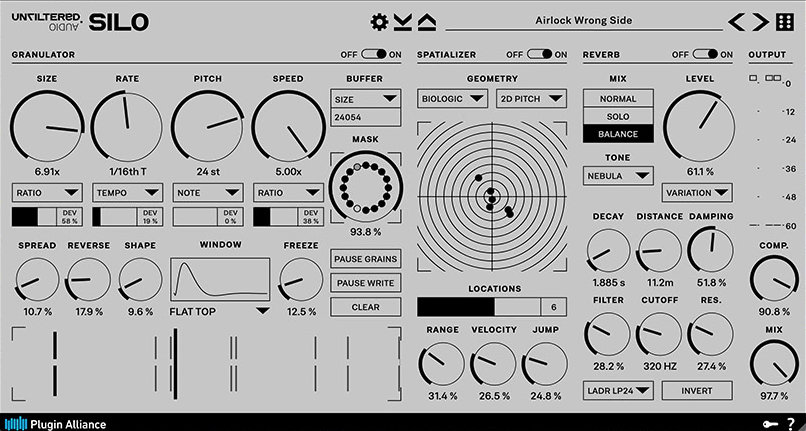
14. LiquidSonics Lustrous Plates
LiquidSonics meticulously captured the characteristics of ten classic plate reverb units during the creation of Lustrous Plates. Their method: temporal acoustic spectral mapping (TASM), which uses a proprietary multiband dynamic capture and analysis. The result is the even diffusion and lush spectral decay of the hardware units this plugin seeks to emulate.
Users can choose from the ten plate models which include chrome, silver, steel, gold and more. Each model has distinct tonal qualities and decay characteristics. The slick-looking Lustrous Plates also features reverb time dampening, frequency dispersion, pre-delay, width, modulation depth & rate, dry/wet blend and output level. The useful equalization section helps to fine tune the timbre of the reverb tails. This is a no-nonsense plugin, and beautiful results can be achieved in very little time.
Mix Tip
Available as a separate plugin, Lustrous Plates Surround is a fantastic choice for engineers who are mixing in the Dolby Atmos format, capable of working in up to a 7.1.6 configuration.
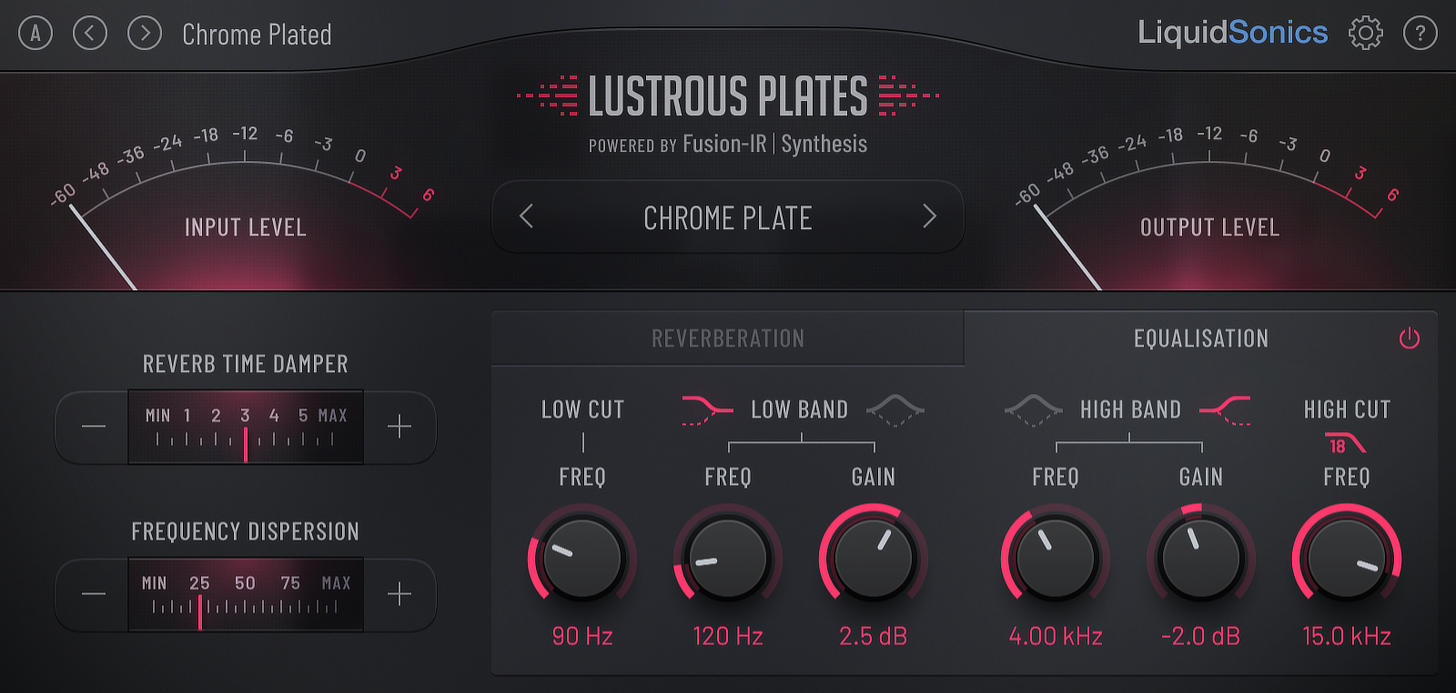
15. D16 Group Spacerek
Similar to the rest of the fantastic collection of plugins from D16 Group, Spacerek features a GUI that looks like a gorgeous high-fidelity rack unit. This reverberator has the feature set and sound quality to match the clean visual aesthetic. D16 Group packed 114 different reverb models into Spacerek including booths, halls, chambers, chapels, towers and more — making it great for both music and post-production duties.
What makes it so flexible is the separate control over early and late reflections. Early reflections are generated by a proprietary “virtual space reverb” engine, which simulates a diverse collection of real-world spaces. Each reverb model defines not only the acoustic properties of the space it emulates, but also the positioning of the stereo speakers and microphones used to send the source signal through that space. This technique results in stunning environmental realism and versatility. Meanwhile, the late reflections are created using a responsive dynamic delay network, which combines seamlessly with the virtual space reverb’s early reflections to create an incredibly natural sounding reverb tail.
Spacerek also features controls for pre-delay for both early and late reflections, a tilt EQ, a mid-side low cut filter and the ability to pan the direct signal and early/late reflections.

16. Your DAW’s Stock Reverb
As with any other type of processing, don’t feel as if you need to go into debt by buying every third-party reverb plugin available. While you might not be able to obtain the colors and authenticity offered by the aforementioned reverbs, a lot can be accomplished using the plugins that come stock with your DAW of choice.
People like to make fun of Avid’s D-Verb, which comes stock with Pro Tools. But if you’ve got to place an element back in the mix, D-Verb is better than nothing. If you’re just getting into music production and mixing, it’s not a bad idea to learn using the tools you’ve got on hand. If you can make something sound nice and lush using D-Verb, then you can likely do the same with the many better sounding (and functioning) tools currently available.
Pro Tools also comes loaded with the AIR Creative Collection which includes a standard reverb, spring reverb and non-linear reverb, all of which are quite serviceable and simple to use.
The Reverb plugin in Ableton is actually quite flexible and sounds good, too. It comes with a “freeze” button, which will freeze the reverb tail as long as the function is activated.
Logic comes with four separate reverb plugins, two of which I use regularly. Space Designer is a handy convolution reverb that features both traditional and wacky impulse responses that can be used to created interesting washed-out textures. I’d argue you can do certain things with Space Designer that you can’t accomplish with any of the aforementioned reverb plugins. Also, Chromaverb is a smooth-sounding, slick-looking reverb plugin that also has a freeze function, as well as both a damping and post EQ, great for sculpting the overall tonality of your tails.
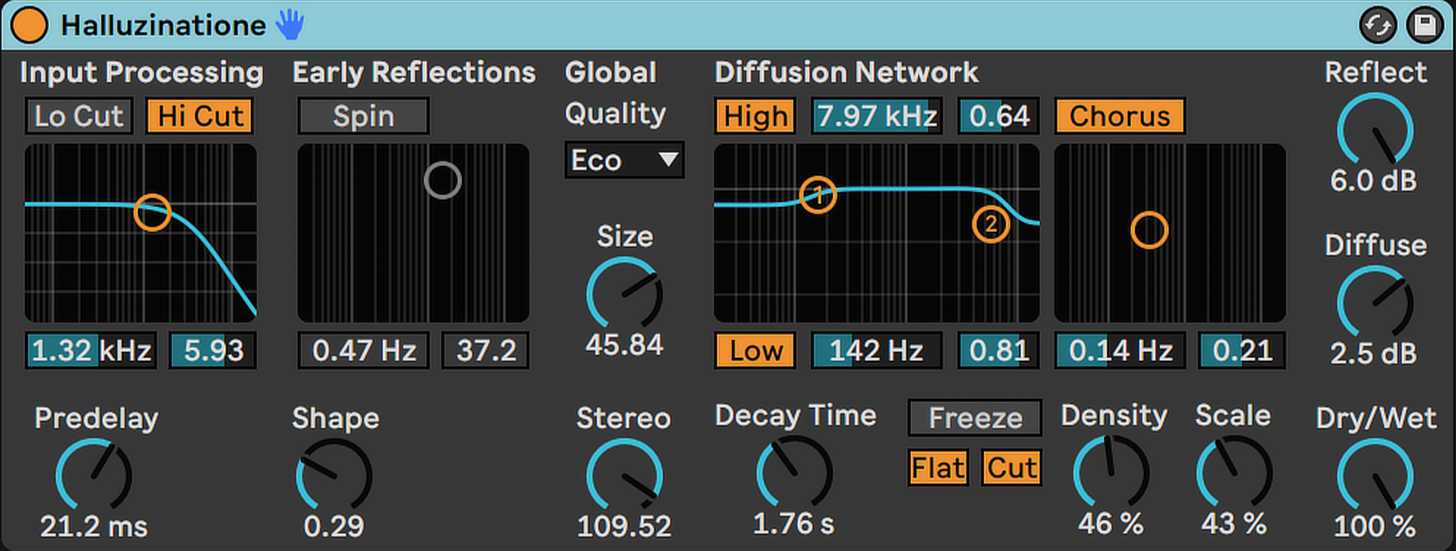
While not all of the aforementioned reverbs are represented in this listening example, check out this tranquil musical cue run through several of my favorite reverb plugins:
No Reverb
Valhalla Huge Synth Space Preset
Valhalla Concert
Soundtoys Little Plate Long Tail
FabFilter Pro-R Resonator Preset
EMT 140
Capitol Chambers
AMS RMX16 Nonlinear
AKG BX 20



